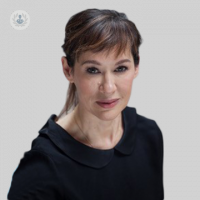Discover age-related macular degeneration (AMD) (part 1)
Autore:The leading cause of vision loss in people over the age of 60, age-related macular degeneration (AMD) is a common condition in which a small part of the central retina called the macula deteriorates, affecting the patient’s central vision. What is having this condition really like? What are the signs to watch out for? What are “dry” and “wet” AMD? We talked to respected ophthalmologist Ms Theresa Richardson, who answered our questions:

What is your vision like when suffering from age-related macular degeneration (AMD)?
This really depends on the stage of macular degeneration. There are two stages: dry and wet.
In the very early stages of dry AMD, you may not notice anything at all, but you may be finding it difficult to read close up, particularly small print, and you will go see your optician. They should be able to tell you have dry AMD, which may cause you some alarm. However, do not be too concerned, as you have few symptoms at this point and may not for many years.
Later, the disease may change from dry AMD to wet AMD, and when this happens, you get a distortion in your vision. Straight lines may appear curved or wiggly, for example, if you look at the side of a table or a window. An optician may give you an Amsler grid to look at to test if you are experiencing distortion of the straight lines.
In the later stages, if you develop a bleed within the eye, then your vision may dramatically change, including a black spot in the centre of your vision. However, this is at very advanced stages and it's unlikely that you will get to this stage.
What is the difference between dry AMD and wet AMD?
This is a question I often get asked by concerned patients.
Dry AMD is often asymptomatic and will usually be spotted by an optician. With time, you'll notice that you cannot see so well when you're reading without very bright lights or unless you have very large print. This may not necessarily mean that you have dry AMD – this is also symptomatic of natural vision loss due to ageing – but it can be an early sign.
When you see your optician, he will take some photographs of the back of the eye and he may well show you pictures of the dry AMD. What we see are small, discreet, yellow dots called drusen. There are two types: they are discreet, dry drusen, and soft drusen. The soft drusen are the ones that will turn into wet AMD.
We classify dry AMD into early (stage one), slightly more advanced (stage two), and then stage three and stage 4, which are more cause for concern. If you're stage 1 or stage 2, you probably may not develop symptoms for many years. You can ask your ophthalmologist which stage you're on and this may help with treatment. The last stages of dry AMD we call atrophy, which is when the tissues in the eye thin slightly and then you develop missing patches. However, this can be overcome by increasing the print size that you use.
Wet AMD is completely different to dry AMD and only ten percent of patients will develop the wet AMD – thank goodness! Wet AMD is a change in the development of the drusen. They start to soak up water and as they do this, they break through a part of the retina called Bruch's membrane. Bruch's membrane forms a barrier between the retina layers and the blood vessels underneath, which provide nutrition to the rest of the eye. When you develop breaks in Bruch's membrane, then the blood vessels start to burst through and they will start to grow inside the retina. They push aside the photoreceptors in the eye, which carry the images to your brain and they start to cause distortion of your vision.
How I always explain it to my patients is if you can imagine a pizza: a tomato base and then you have the cheese on top, and the tomato is supposed to stay under the cheese. If the cheese starts to stretch and the tomato comes up and goes on top, that is like the blood vessels passing through the retina, causing the black splotches and distortion. So, what we need to do is to stop that tomato sauce coming up onto your retina, and we do have treatments for that. In conclusion, wet AMD is completely different to dry, and you notice it due to distorted vision.


